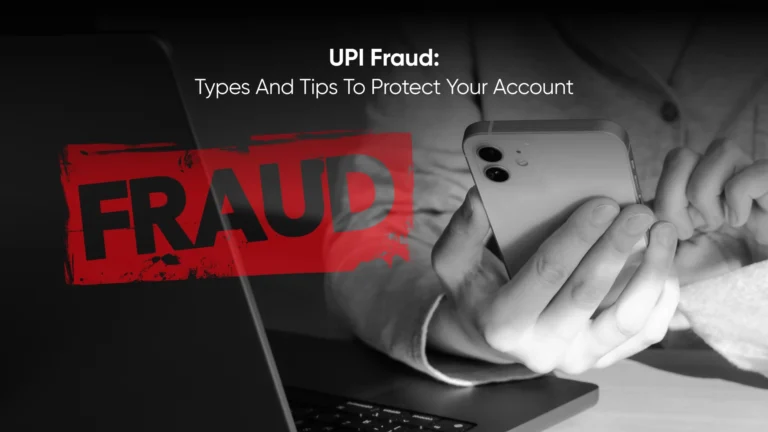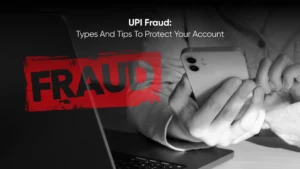UPI fraud is when scammers use tactics to hack your Unified Payments Interface (UPI) account that can lead to unauthorized money transfers from your account. They usually do this by impersonation, phishing, or fake payment requests to extort money from these accounts. They trick people with malicious QR codes, UPI payment links, or fake UPI apps. Their goal is to steal money or gain access to a victim’s banking information by manipulating the payment process or exploiting user emotions and urgency.
Table of Contents
ToggleWhat is UPI Fraud?
UPI fraud is a digital scam where fraudsters trick users into revealing their PIN, OTP, or approving fake transactions, leading to financial loss. Since Unified Payments Interface (UPI) enables instant bank-to-bank transfers via mobile apps, scammers exploit it through methods like phishing links, fake customer support calls, screen-sharing apps, or malicious payment requests.
Common Types of UPI Frauds in India
Digital transactions have become easier than ever, due to the rapid adoption of UPI in India. On the flipside, UPI payment scams and related frauds are on the rise. Fraudsters use various techniques to trick users into sharing sensitive information and unknowingly transferring money. Being aware of these common types of UPI fraud can help you stay alert and protect your finances.
Phishing Scams
Phishing is one of the most common scams around. Usually, fraudsters send fake emails, SMS, or calls that look like they’re from a trusted bank or UPI app. These messages often include urgent requests like “update your KYC” or “verify your account” and ask for sensitive details such as UPI PINs, OTPs, or login credentials. Once shared, fraudsters gain full access to your account and can transfer money instantly.
SIM Card Swapping
In this scam, criminals trick mobile service providers to issue a duplicate SIM card by posing as the genuine user. Once the SIM is swapped, the fraudster gains control over the victim’s mobile number. This allows them to intercept OTPs and SMS alerts, enabling unauthorized UPI transactions and draining accounts without the user’s immediate knowledge.
App Cloning and Fake UPI Apps
Fraudsters often create similar UPI apps that closely resemble legitimate ones like BHIM, Google Pay, or PhonePe. Unsuspecting users who download these apps from unofficial sources end up giving away their personal details and bank information. These fake apps steal login credentials, making it critical to only download apps from official stores such as Google Play Store or Apple App Store.
QR Code Scams
Quick Response (QR) codes are popular for payments, but scammers exploit them by distributing tampered or fake QR codes. Instead of receiving money, users may unknowingly authorize payments to fraudsters by scanning these codes.
Impersonation
Many fraudsters pose as bank representatives, customer care agents, or police officers, accusing the user of some crime. By creating a sense of urgency, such as claiming there’s a problem with your account or requesting to share personal data, they convince victims to transfer money.
Remote Access Frauds
Scammers often trick users into downloading remote access software on their phones, such as screen-sharing apps, under the guise of offering technical support. Once access is granted, fraudsters can view sensitive information, including UPI PINs or OTPs, and execute unauthorized transactions while the user remains unaware.
Malicious Payment Links
Fraudsters circulate fraudulent links via SMS, email, or messaging apps that look like legitimate payment requests or cashback offers. Clicking on these links may redirect users to fraudulent pages or trigger auto-debit transactions without explicit consent. Many victims fall prey to such scams and realize too late that money has been debited from their accounts.
How to Report a Fraud UPI Transaction in India
If you ever fall victim to a UPI fraud, it is best to act fast and report it. Here’s a step-by-step guide to help you report a fraudulent UPI transaction and improve your chances of recovering funds:
1. Take Immediate Action
The moment you notice an unauthorized transaction, don’t delay. Note down the transaction details such as date, time, UPI ID, and amount. Quick reporting significantly increases the chances of resolution.
2. Contact Your Bank and UPI App Support
Call your bank’s customer care helpline or visit the nearest branch to report the fraud. Banks are required by RBI guidelines to register your complaint and start investigating immediately.
Simultaneously, raise a complaint through your UPI app by using their in-app “Help” or “Report Transaction” option.
3. File a Complaint with NPCI
If the issue is not resolved through your bank, you can escalate it to the National Payments Corporation of India (NPCI), which regulates UPI. Visit the NPCI Dispute Redressal System and file a complaint with transaction details.
4. Report to Cyber Crime Authorities
File a complaint on the National Cyber Crime Reporting Portal: www.cybercrime.gov.in. You can also dial the Cyber Crime Helpline 1930 to report financial fraud.
In serious cases, lodge an FIR with your local police station to keep the matter officially recorded.
5. Keep Documentation and Evidence Ready
Maintain a record of Transaction ID, screenshots, and SMS/email alerts. This documentation is critical if the case needs escalation or legal intervention.
6. Use Customer Care and Grievance Redressal Forums
If you are unsatisfied with your bank’s response, escalate the complaint to the Banking Ombudsman through RBI’s grievance redressal system. This ensures independent review of your case.
In essence, acting quickly is the most effective way to minimize losses in a UPI fraud case. Always report within 24 hours, track complaint numbers, and escalate through NPCI, cyber crime portals, and RBI forums if necessary.
Also Read: Advantages and Disadvantages of UPI Payments While Using for Money Transfer
Essential Tips to Protect Your UPI Account from Frauds
Unified Payments Interface (UPI) has become one of India’s most popular ways to transfer money quickly. However, with the rise of UPI payment scams, fraudsters often trick people through fake apps, phishing links, or fake payment calls. Here are some essential tips to help you protect your UPI account and keep your money safe:
1. Never Share Your UPI PIN or OTP
Your UPI PIN and one-time passwords (OTPs) are strictly personal. Banks and UPI apps will never take these from you. If anyone requests them, whether over a call, SMS, or email, it’s a red flag.
2. Avoid Clicking Suspicious Links
Fraudsters often send fake payment links through SMS, WhatsApp, or emails that look genuine. Never click on links from unknown sources. Always use your UPI app directly for transactions instead of relying on forwarded links.
3. Verify Merchant Details Before Paying
Before making payments, especially to new contacts or merchants, double-check their details. Look for verified tick marks on apps and confirm UPI IDs carefully to avoid sending money to fraudulent accounts.
4. Download UPI Apps Only from Official App Stores
Many scams begin with fake apps that mimic popular UPI platforms. Always download UPI apps only from trusted sources like Google Play Store or Apple App Store. Avoid random APK files or third-party downloads.
5. Enable App Lock and Two-Factor Authentication (2FA)
Adding an extra layer of security is essential. Use your phone’s biometric lock or PIN to secure the UPI app. Where possible, activate two-factor authentication to ensure that even if your phone security is compromised, your account remains safe.
6. Keep Apps and OS Updated
Outdated apps or operating systems (OS) make you more vulnerable to cyber threats. Regular updates come with critical security patches. Turn on automatic updates to stay protected.
7. Set Daily Transaction Limits
Most UPI apps allow you to set a daily transaction limit. This ensures, in case of fraud, someone does withdraw money, it will only be up to the spending limit.
8. Monitor Transaction Alerts Carefully
Always check SMS and in-app alerts for transactions. If you notice any unfamiliar activity, report it to your bank immediately. Timely action can often stop fraudulent activity.
9. Avoid Public Display of UPI IDs
Refrain from sharing your UPI ID openly on social media, forums, or public groups. Fraudsters may use this information to trick you with phishing requests or false payment messages.
10. Reject Unsolicited Calls Asking for Payment Details
Never trust callers claiming to be bank officials or customer service agents asking for UPI credentials. Legitimate institutions will not ask for such sensitive details. If in doubt, contact your bank directly through official channels.
UPI is a safe and convenient tool when used correctly. If you use it carefully, stay alert, and become aware of common scams, you can save yourself from such fraudulent activities. Remember, digital safety begins with personal vigilance.
The Legal Framework and Consumer Protection for UPI Users in India
The convenience of UPI payments has increased its user base to a high level in India. However, with the high adoption of UPI in India, it has also led to the rise of UPI fraud. To tackle this issue and safeguard users, the Reserve Bank of India (RBI) and the National Payments Corporation of India (NPCI) regulate UPI transactions. RBI sets the legal and regulatory framework for secure payments, while NPCI oversees the UPI platform’s operation and ensures compliance. They also issue guidelines to banks and payment service providers to prevent misuse.
This framework gives users the right to report a fraudulent UPI transaction to their bank immediately. Banks are mandated to have the correct channels to the users for lodging complaints, be it through mobile apps, helplines, and grievance redressal portals. In most cases, a bank must acknowledge the complaint quickly and initiate the dispute resolution process.
If a user reports fraud promptly, the bank is required to investigate and refund the customer within a specified period, depending on the case. To strengthen consumer protection, RBI has also directed all banks to follow the zero-liability and limited-liability policies. This ensures that if a fraud occurs without customer negligence, the victim will not bear the financial loss. Users are urged not to click on any suspicious links, avoid sharing UPI PINs or OTPs, and immediately report any unauthorised transactions. Quick action not only helps secure refunds but also assists banks and authorities in curbing future fraud.
FAQs About UPI Fraud and Safety in India
What Should I Do Immediately If I Suspect a UPI Fraud?
If you suspect UPI fraud, block your UPI service immediately. Report the incident to the National Cyber Crime Reporting Portal or call 1930.
Can I Get My Money Back After A Fraudulent UPI Transaction?
Yes, you can get your money back after a fraudulent UPI transaction if you act immediately. Report to your bank and the police to resolve it at the earliest.
How Can I Identify Fake UPI Payment Links Or Apps?
Always download apps from Google PlayStore or Apple App Store. Do not click on unknown links. Verify the UPI ID before sending any money.
Is It Safe To Share My UPI ID Or VBA?
Yes, it is safe to share your UPI ID for payments. However, never share your UPI PIN with anyone.
How Often Should I Change My UPI Pin?
Ideally, you can change your UPI PIN every few months.
What Are The Common Signs Of SIM Swapping Affecting My UPI Account?
Losing access to a bank account or any unexpected large transaction are some common signs of SIM swapping that may affect your UPI account.









